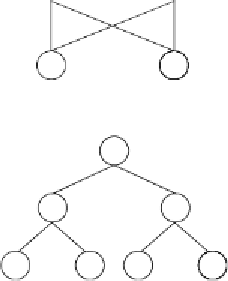Information Technology Reference
In-Depth Information
Furthermore, special mutation operators were created that allow the perma-
nent introduction of variation in the set of weights and thresholds.
It is worth emphasizing that the basic genetic operators such as mutation,
inversion, IS and RIS transposition, are not affected by Dw or Dt as long as
the boundaries of each region are maintained and the alphabets of each do-
main are used correctly within the confines of the respective domains. Note
also that this mixing of alphabets is not a problem for the recombinational
operators and, consequently, their port to GEP-nets is straightforward. How-
ever, these operators pose other problems that will be addressed later in the
next section.
Consider, for instance, the conventionally represented neural network with
two input units (
i
1
and
i
2
), two hidden units (
h
1
and
h
2
), and one output unit
(
o
1
) (for simplicity, the thresholds are all equal to one and are omitted):
o1
5
6
h1
h2
2
3
1
4
i1
i2
It can also be represented by a conventional tree:
D
5
6
D
D
1
2
3
4
a
b
a
b
where
a
and
b
represent, respectively, the two inputs
i
1
and
i
2
and “D” repre-
sents a function with connectivity two. This function multiplies the values of
the arguments by the respective weights and adds all the incoming activation
in order to determine the forwarded output. This output (zero or one) de-
pends on the threshold, that is, if the total incoming activation is equal to or
greater than the threshold, then the output is one, zero otherwise.
We could linearize the above NN-tree as follows:
0123456
789012
DDDabab
123456
where the structure in bold (Dw) encodes the weights. The values of each





